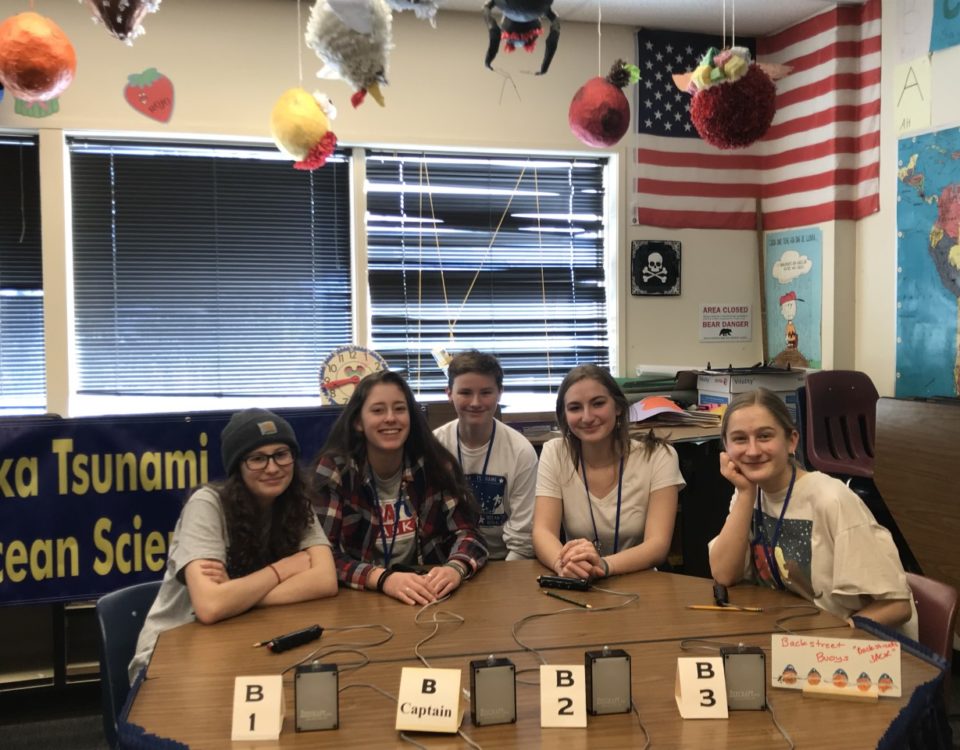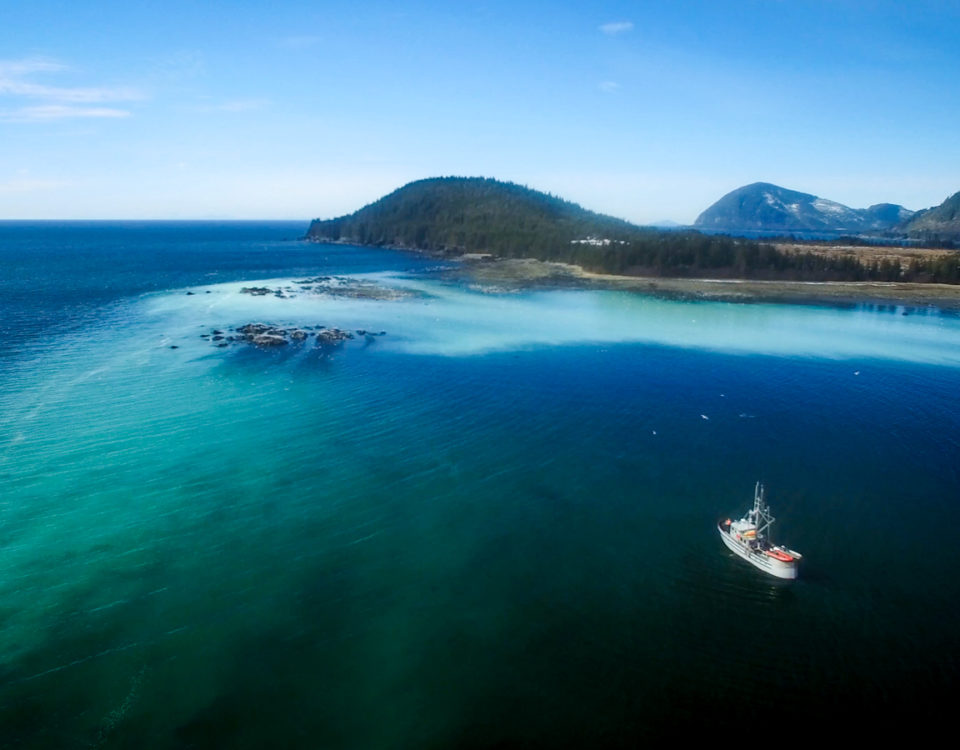Ocean Tracking Network Research Cruise

For the last 10 years, the Prince William Sound Science Center has maintained underwater acoustic arrays, a technology to tag and track marine animals, in Prince William Sound. The acoustic arrays are basically numerous individual tracking devices (acoustic receivers) that are placed about 600-700 meters apart from each other to record the date, time and individual identification code of any tagged fish or animals that pass by. The first arrays were deployed in Port Gravina in 2008 as part of the Pacific Ocean Shelf Tracking (POST) project where the Science Center tagged lingcod and Pacific herring while Stanford University tagged salmon sharks.
The POST project segued into a partnership with the Ocean Tracking Network, headquartered in Dalhousie University in Canada, in 2013. The Ocean Tracking Network provided funding to deploy 49 acoustic receivers across the major entrances into Prince William Sound. The receivers are grouped into six arrays in Hinchinbrook Entrance, Montague Strait, and the Sound’s four southwest passages. This technology has opened up new opportunities to understand how fish stocks found in Prince William Sound interact with the Gulf of Alaska—something we know very little about. Projects like the Science Center’s Pacific Cod migratory connectivity project and the Tracking Seasonal Movements of Adult Pacific Herring project use these arrays to learn if fish are leaving the Sound to forage or overwinter in the Gulf of Alaska and if so, when?
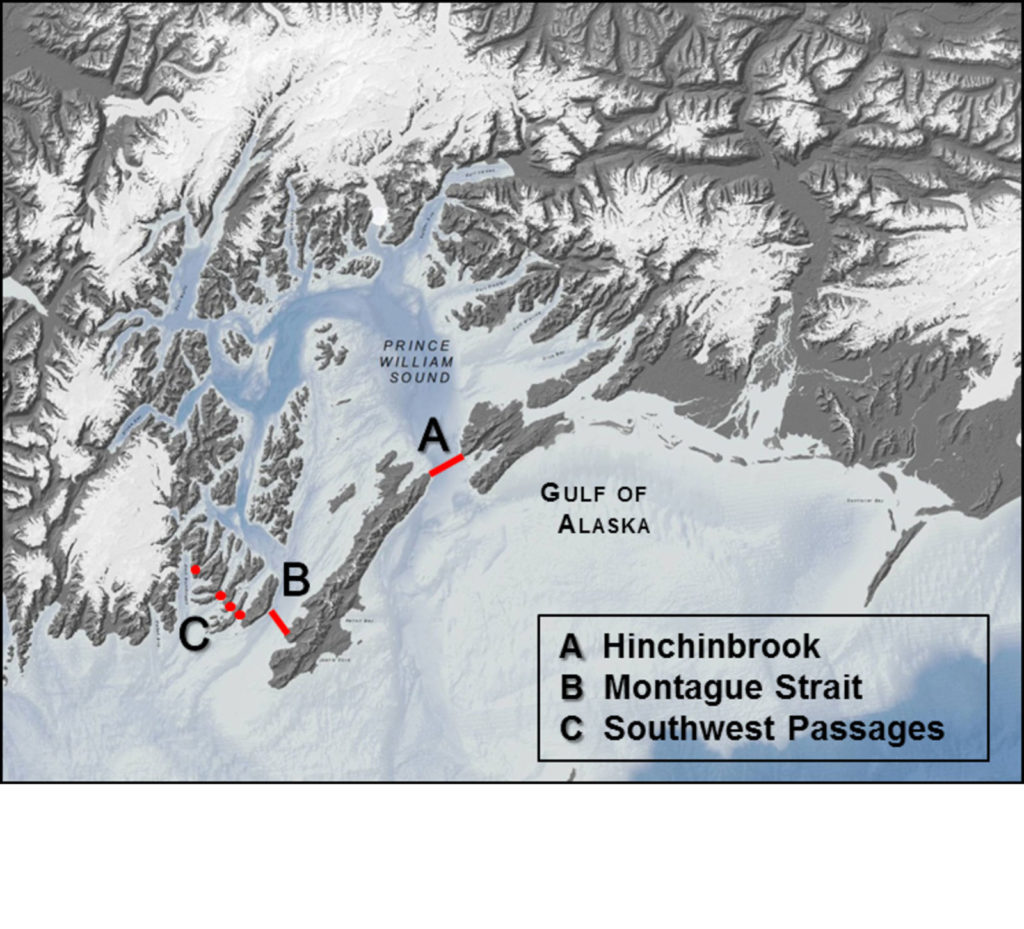
Dr. Mary Anne Bishop and three research assistants from the Prince William Sound Science Center recently spent six days uploading data and maintaining the acoustic arrays that track tagged fish and animals at the main entrances to Prince William Sound. The red lines on this map represent the six different arrays that are made up of 49 underwater acoustic receivers.
At least once a year Dr. Mary Anne Bishop and research assistants from the PWSSC go on a research cruise to do maintenance and upload data from the acoustic receivers. Depending on the model of the receiver, the researchers either hover over the receiver and upload the data via modem connection (surface to receiver), or they bring the receiver to the surface and hook it up to a computer via Bluetooth. The models that are set up to transfer data via modem stay down for five years before scientists bring them to the surface for maintenance. Each receiver is moored on the bottom of the ocean with heavy chain. The chain is connected by a line to an ‘acoustic release’ which hangs just below the receiver. More line is attached to the top of the receiver which attaches it to an underwater buoy. To bring the receivers to the surface the scientists type release commands into a deck box which is connected to a transducer that is put in the water. The release commands are picked up by the acoustic release which then releases the line that is attached to its mooring. The buoy floats to the surface trailing the acoustic receiver and acoustic release behind it.
When the buoy reaches the surface, the researchers pull it all on board the research vessel and do any necessary downloading and maintenance before deploying the acoustic release back to the same place with a new mooring chain. Maintenance often includes removing any biofouling (barnacles and caprellid amphipods that have made their home on the devices), replacing batteries, checking O-rings, replacing desiccant packs that remove any internal moisture and applying zinc oxide heavy diaper paste to reduce biofouling. It takes the crew about a week to download the data and do maintenance on the 49 receivers, typically bringing about 14 of them to the surface for the full treatment.
When the crew gets back to town they upload the data to the Ocean Tracking Network’s global database and clean it up (culling through it to remove any incomplete, incorrect or inaccurate data), before using it as a data set in their research. This data is transforming what we know about the relationships that fish populations in Prince William Sound have with the Gulf of Alaska. Results from projects like the Pacific Cod project, and the Tracking Seasonal Movements of Adult Pacific Herring project will ultimately be used to responsibly manage fish populations in Prince William Sound for the long run.
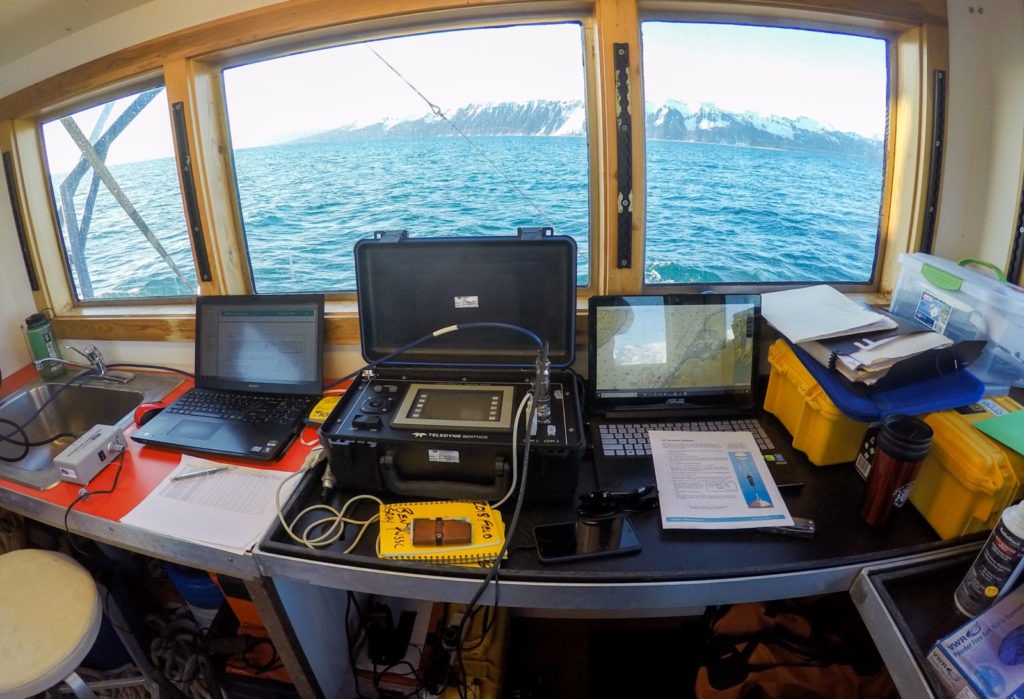
Although some of the acoustic receivers have to be brought to the surface annually to upload the data, many are designed to be moored for five years or longer and researchers are able to upload the data via modem connection (surface to receiver). As the boat hovers near the receiver the surface modem that is connected to the deck box/computer in the middle of this photo is lowered into the water below the keel of the boat. Depending on the amount of fish detections, it takes anywhere from five minutes to over an hour to transfer a year of data in this way. Photo by Ben Gray.
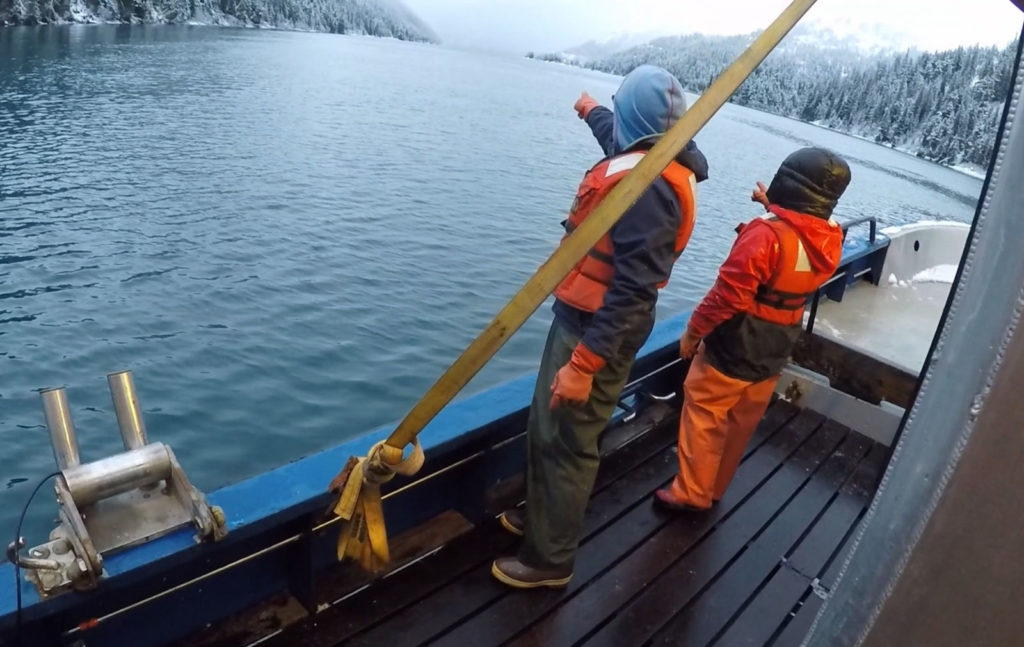
Research assistants Kirsti Jurica and Anne Schaefer point to a released buoy that just broke the surface. A line under the buoy is attached to the acoustic receiver and acoustic release that they will upload data from. Photo by Ben Gray.
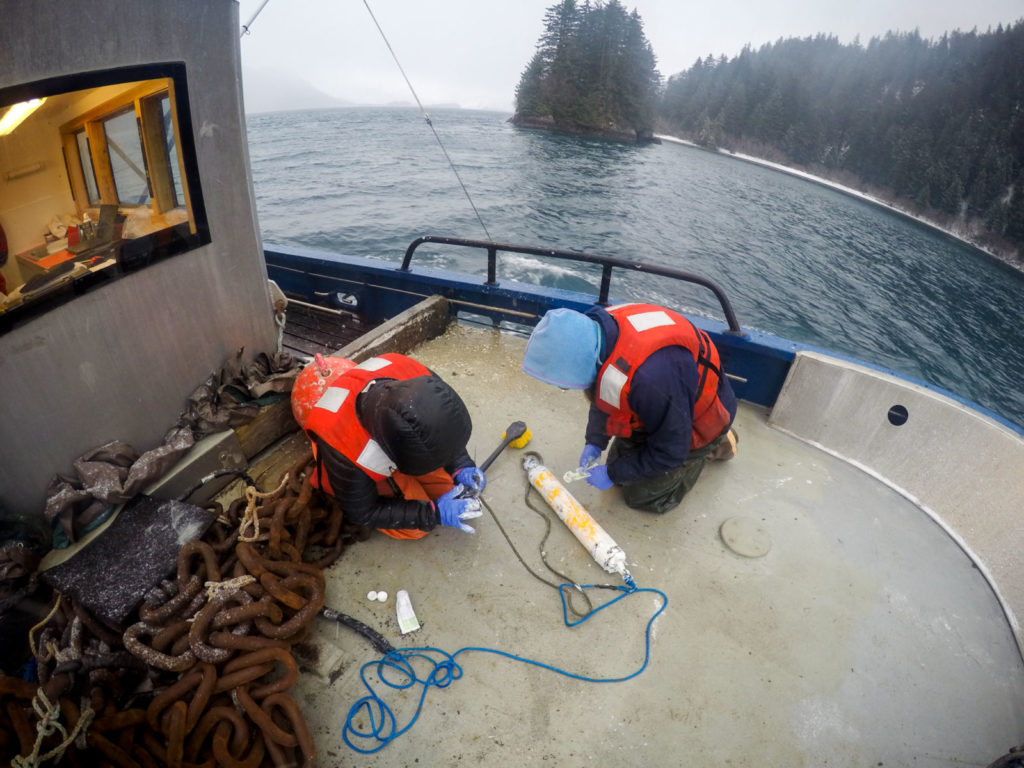
Anne Schaefer and Kirsti Jurica apply diaper paste to an acoustic release. The diaper paste has a high concentration of zinc oxide and reduces biofouling (biological growth of barnacles and caprellid amphipods). Too much biofouling can weigh down the buoy and possibly interfere with communications between the surface and the acoustic releases. Photo by Ben Gray.
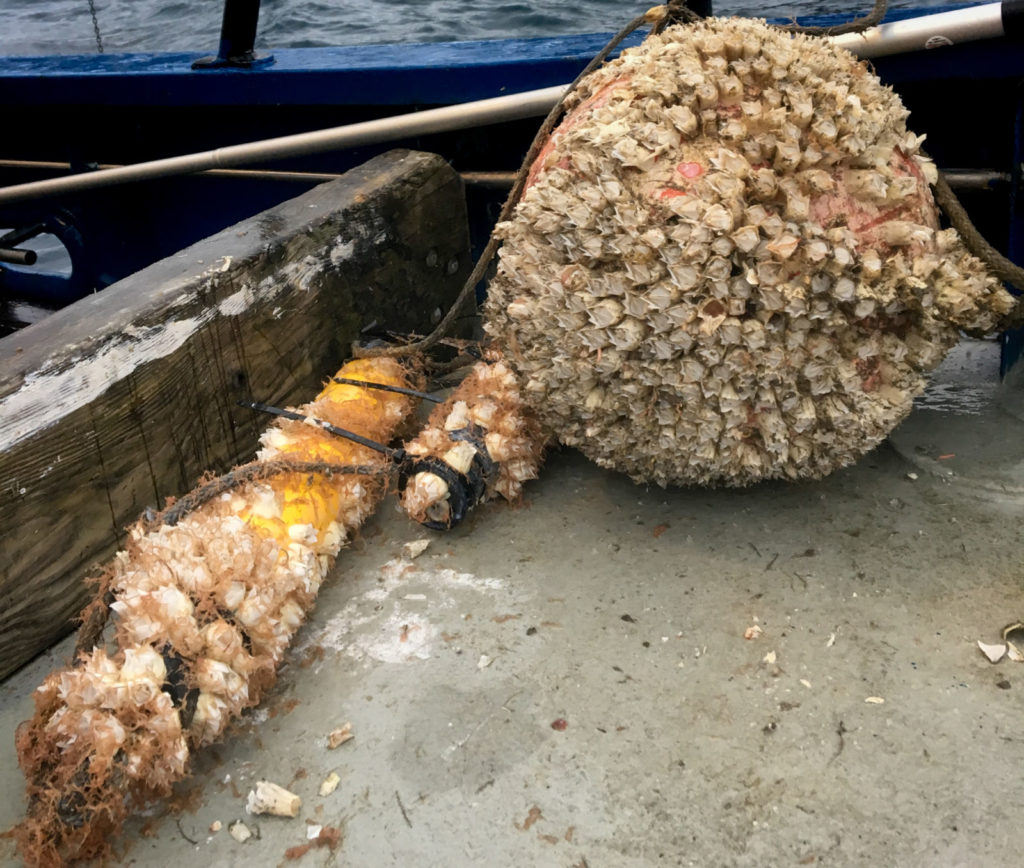
In some locations, such as Elrington Pass, no amount of diaper paste can counteract the biofouling. Here, the buoy, acoustic receiver, and acoustic release were heavily colonized by barnacles and caprellid amphipods. This is only one year’s growth. Photo by Anne Schaefer.
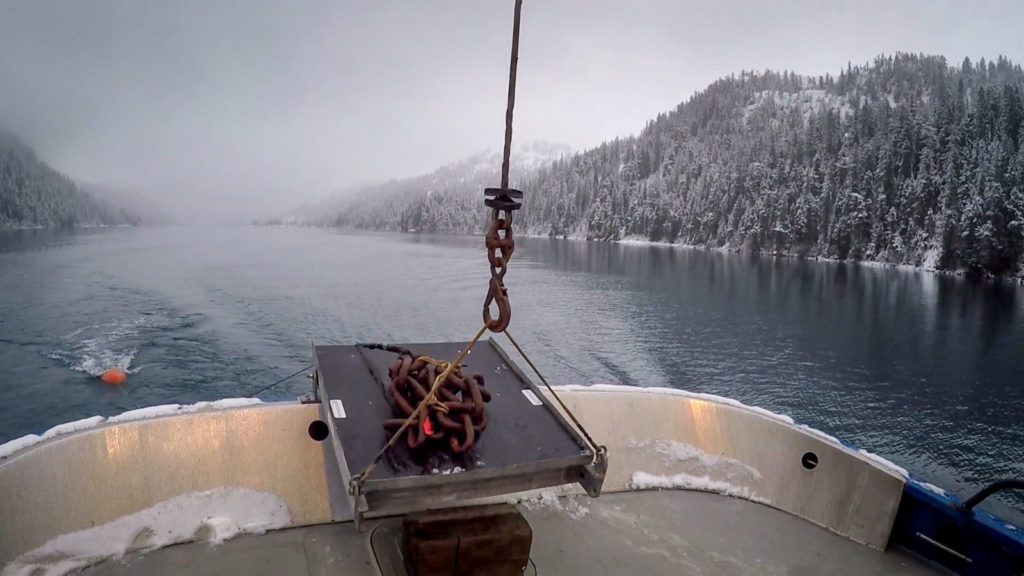
When the boat reaches the correct location, this mooring chain (with an acoustic receiver, acoustic release, and buoy attached) will be dumped overboard to spend the next year underwater, collecting data on the movement of fish and animals in and out of Prince William Sound. Photo by Ben Gray.
Recommended reading to learn more about the research projects referenced in this article:
Herring:
https://pwssc.org/herring-research-and-monitoring/
https://pwssc.org/tracking-seasonal-movements-of-adult-pacific-herring/
Bishop, M.A. and J. Eiler. 2018. Migration patterns of spring-spawning Pacific Herring in Alaska’s Prince William Sound. Deep Sea Research II http://dx.doi.org/10.1016/j.dsr2.2017.04.016
Eiler, J. and M.A. Bishop. 2016. Determining the post-spawning movements of Pacific herring, a small pelagic forage fish sensitive to handling, with acoustic telemetry. Transactions of American Fisheries Society. 145:2, 427-439, http://dx.doi.org/10.1080/00028487.2015.1125948
Pacific Cod:
https://pwssc.org/pacific-cod/
POST:
www.coml.org/pacific-ocean-shelf-tracking-post/
Lingcod:
Bishop, M.A., B.F. Reynolds, and S.P. Powers. 2010. An in situ, individual-based approach to quantify connectivity of marine fish: ontogenetic movements and residency of lingcod. PLoS ONE 5(12): e14267. https://doi.org/10.1371/journal.pone.0014267
The Ocean Tracking Network:
https://pwssc.org/ocean-tracking-network/
http://oceantrackingnetwork.org


